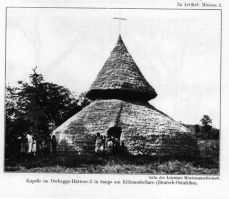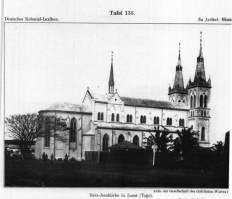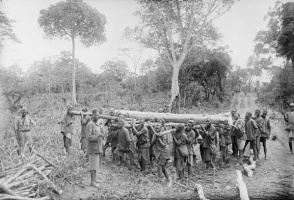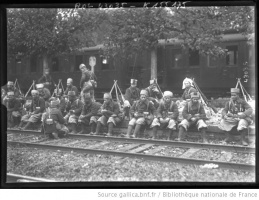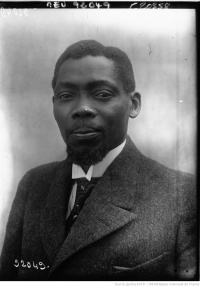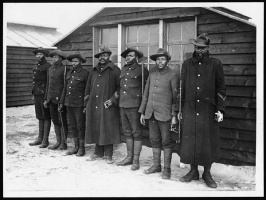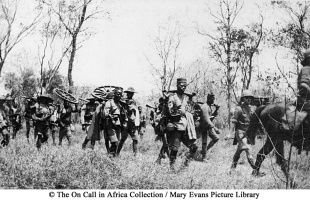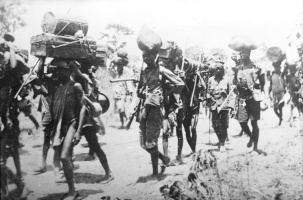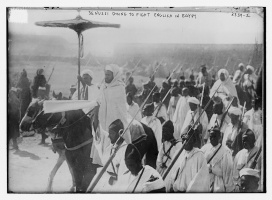Introduction↑
African peoples fought back against overbearing colonial demands during the First World War. With few exceptions, Africans had played almost no role in the decisions and acts that started the war, in defining war aims, or in determining how it would be prosecuted.[1] Yet European colonial powers expected African participation in the war effort. They also expected Africans to demonstrate absolute loyalty to imperial causes. The colonizers’ wartime priorities and the large-scale abuses they unleashed exposed the colonial state’s exploitative capacities on a new scale. Many African polities fought to challenge or overturn the colonial order.
It is a mistake, however, to view the many acts of “resistance and rebellion”[2] that occurred during the war as confined to the temporal boundaries of 1914-1918.[3] The conditions that led African peoples to resist colonial rule often emerged from longstanding grievances against colonial labor exploitation, taxation, racist and paternalist practices, arbitrary violence, and political illegitimacy. Historical explanations of resistance during the war prioritize colonial fears about losing control of their colonies in the midst of war. But the roots of the often violent expressions of outrage that occurred between 1914 and 1918 are located in the diverse local and regional priorities of those who undertook actions later cast as “anti-colonial.”
Wartime acts of resistance are best viewed as flashpoints in a longer history of imperial incursions on the continent, with harsh wartime conditions catalyzing action. They cannot be explained by single causal factors, as they frequently drew on multiple discontents. Some polities took up arms with the intent of overthrowing colonial rule or reconfiguring existing political arrangements between African polities. Others refused recruitment into colonial armies or labor forces. Still others refused to pay taxes, interrupting colonial revenue streams. As the colonizers’ priorities shifted in the face of wartime exigencies, many Africans interpreted the war as a sign of deeper colonial entrenchment and fought back.
They did so by drawing on the specific institutions, processes, and practices that had shaped their everyday lives before the war.[4] Religious networks and complexes provided regional grammars for interpreting meanings of unfolding events.[5] Local and regional socio-economic hierarchies also shaped how Africans viewed the war’s outbreak. Colonial state authorities often created the conditions that shaped how Africans experienced the war’s onset. But the ways that Africans perceived, negotiated, or challenged these conditions deserve equal attention in interpreting resistance during the war. This essay illustrates how intertwined pressures sparked African resistance, and colonial retaliation, during the war years.
Labor Refusal↑
The violent onslaught of colonialism that occurred between 1890 and 1914 established new work regimes, in which colonial labor demands interfered with local labor practices. Colonizers exploited African workers by paying low or no wages, often working with local African leaders to secure labor levies. They offered incentives to encourage these leaders to cooperate and often threatened violence for non-compliance.[6] Africans who were accused of crimes, owed debts, or were otherwise obligated to provide labor to their local patrons were vulnerable to colonial labor demands. These kinds of labor arrangements violated local understandings of who could legitimately demand labor, underscoring a more general colonial crisis of legitimacy. The language of chronic “labor shortages” heightened colonial sensitivities about regulating how and where Africans worked and prioritized colonial interests above all others.[7]
Africans escaped colonial military and administrative abuses through avoidance tactics. Hearing of approaching colonial armies, tax collectors, or labor recruiters, Africans fled their homes or concealed themselves to avoid violent confrontations and dispossession. When World War I began, Africans recognized that the colonizers’ seemingly insatiable labor needs would increase exponentially.[8] African efforts to avoid forced labor disrupted war recruitment goals and the war effort more generally. In rural Senegal, for example, “for every soldier recruited [. . .] between 1914 and 1917, another potential inductee fled the colony to seek refuge in foreign territories.”[9] Similar examples occurred in different parts of Nigeria, as well as Guinea and Dahomey (today Benin).[10] In Portuguese East Africa (Mozambique) too, recruitment pressures drove the Barue to take up arms against the Portuguese in 1917.[11]
Africans also used a range of “passive” tactics to escape wartime service. These included crossing borders into neighboring colonies to hide from recruiters or participating in alternative labor economies less vulnerable to military conscription.[12] Some found respite in Christian missions, or “anonymity” in remote colonial districts with limited administrative presence.[13] Conscripts also malingered, discarded loads, feigned sickness, and purposely misunderstood orders.[14] Many soldiers and porters simply deserted or sought to better their circumstances by crossing lines.[15] These acts, though less spectacular than other forms of resistance, proved disruptive to military campaigns. For example, in October 1915, “a shortage of porters slowed the British advance on Banyo” in northern Cameroon.[16]
These actions directly affected wartime colonial economies and politics. In Nigeria, public works projects such as railway construction stalled as African resistance hampered labor recruiters’ ability to make their numbers. In the Gold Coast, Africans’ unwillingness to work for the colonizers negatively affected agricultural production and mining interests.[17] On the other hand, refugees who ended up in the Gold Coast after fleeing military recruitment in neighboring French territories helped shore up the colonial labor force for mining and related road-building projects.[18] In the Gold Coast, wage laborers struck for better pay and work conditions in the face of wartime hikes in staple food prices.[19] One legacy of this resistance was the formation of labor unions in the postwar period, marking a fundamental shift in how Africans negotiated their labor relationships to the colonial state.[20]
African peoples had harbored simmering resentments and anger against colonial administrative intrusions, especially regarding labor demands. While these sometimes found violent expression between 1914 and 1918, they were rooted in colonial abuses of the pre-war years. In 1912, British colonial officials addressed white settler calls for more plantation labor by trying to more closely administer the Giriama, who lived in Kenya’s coastal hinterland.[21] Up to this point, the Giriama had maintained autonomy despite steady British encroachment in the region.[22] Giriama elders, whose authority was tied to their control of young men’s labor, refused to assist the local British administrator in recruiting laborers or collecting taxes.[23] Mekatilili, a charismatic woman prophet who drew on “an established tradition of female prophecy” further enjoined the Giriama to refuse British requests.[24] Her public speeches reinforced the material grounds for Giriama protest with a spiritual call to restore community equilibrium through resistance.[25] British colonial troops’ destruction of a ritual center (the kaya) in August 1914 in retaliation for continued Giriama defiance bolstered their resolve to resist.
That same month, with news of the war’s outbreak, British efforts to secure porters for the war effort took on new urgency. They unsuccessfully pressured the Giriama to provide this manpower. The rape of a Giriama woman by a colonial soldier “gave local Giriama the incentive they needed to fight.”[26] Armed with bows and arrows, Giriama fighters shot at British forces and mission stations, inflicting minimal damage. But soldiers of the British colonial army, the King’s African Rifles (KAR), inflicted massive damage on the Giriama in return: “The troops fired on all Giriama they met, whether or not they were hostile, and systematically confiscated goats and burned dwellings.”[27] The Giriama refused to make peace, and British reprisals against them continued into October 1914. In 1915, the KAR forced the Giriama into a reserve, though many escaped. The British imposed a major fine, and ordered 1,000 porters to work for the KAR, now fully engaged in fighting the Germans in the East African campaign. A combination of drought, crop failure, and loss of livestock caused widespread hunger. To pay the fine leveled against them in 1915, they had to leverage their 1916 harvest: “They saw their old granary across the river sit uncultivated while they went hungry.”[28] Giriama resistance to British attempts to tighten their administrative hold on them starting in 1912 cost them their economic independence, “relegat[ing] [them] to the backwater, both economically and politically, from 1920 onward.”[29] The longer historical context of unequal relations between colonizers and colonized is vital to understanding resistance between 1914 and 1918.[30] Giriama efforts to defend their political autonomy failed, but they disrupted colonial visions of order and security at a critical moment.
Chilembwe’s War: Millenarianism, Elites, and Resistance↑
Further southeast in British Nyasaland (Malawi), similar dynamics were unfolding. Like the Giriama, Africans in Nyasaland lived in an area where the harsh effects of the East African campaign were felt intensely. The scope of new British recruitment drives alarmed Malawians, who anticipated drastic changes to communal life as a result. Drawing on regional prophetic traditions and millenarianism, many interpreted the Great War’s outbreak as a portentous moment for radical change.
Chilembwe’s rebellion, which took place in January 1915 in Nyasaland, is one of the best studied organized rebellions of the war in Africa, and a compelling example of the power of religious movements to shape how Africans interpreted events as they unfolded before, during, and after the war.[31] John Chilembwe (1871-1915), a Baptist pastor who headed the Providence Industrial Mission (PIM), a large congregation in Chiradzulu District, channeled collective outrage in and around his parish. A religious radical with egalitarian ideals who received his theological education and ordination in the United States, Chilembwe became a vocal critic of colonial abuses and an equally vocal advocate for African independent Christian churches. Rumors of war between the British and Germans and anticipation of increased labor demands added new urgency to his activism. The PIM’s proximity to the Bruce Plantation—a visible site of African land alienation, colonial exploitation, and abusive labor practices—stoked Chilembwe’s insurrectionary vision. The coincidental appearance of various meteorological and celestial signs in the years prior to the war added gravity to Chilembwe’s interpretation of the war as a cataclysmic event that would destroy Malawians if they did not act.[32]
As British labor recruitment methods, especially for porters, gathered force in Nyasaland in late 1914, Chilembwe began inciting his congregants—many of whom were teachers and thus members of the emergent African middle class—to attack British settlers and their interests. Angered by long-term colonial exploitation of local populations, they absorbed Chilembwe’s message that violence would bring sweeping change.
On 23 January 1915, men from Chilembwe’s congregation attacked Europeans at the Bruce estates, killing three men. They also raided a local colonial arsenal to seize weapons and ammunition, resulting in the capture of four insurgents. Small attacks continued over the next few days, killing one African policeman, injuring a Catholic missionary, and destroying parts of his mission. Colonial soldiers and European reservists responded immediately, taking over the PIM on 25 January and capturing the remaining insurgents.They were imprisoned and, in some cases, executed. Chilembwe attempted to escape into neighboring Portuguese East Africa (Mozambique), but was caught and killed by a British colonial soldier (askari).[33]
The rebellion ignited security fears for colonial authorities and settlers in Nyasaland and beyond.[34] A Commission of Inquiry formed in 1915 investigated the rebellion’s causes, publishing its findings in January 1916. According to the report, Chilembwe bore responsibility for causing the uprising, but the report also criticized the Bruce Estate for egregious abuses of African workers, including poor pay, floggings, and overwork.[35]
For the rest of the war and after, Chilembwe’s rebellion served as a reminder to colonial officials of their utter dependence on African labor. The PIM’s resistance signaled wider patterns of growth in independent African Christian churches, the making of an African educated elite class, and the radical possibilities their religious beliefs and practices suggested.[36] During the war, white European missionaries often joined the colonial armies as officers and NCOs, leaving their mission stations behind. African mission personnel stepped in, taking over day-to-day station management, including preaching, teaching, cultivating crops, managing livestock herds, and providing health care. This arrangement served missionary and colonial needs, but also had the potential to undermine them.
Chilembwe’s rebellion was just one example of how spiritual communities could be mobilized to resist colonialism and especially the wartime abuses that deepened the anger many colonized peoples felt about their conditions. As noted earlier, the Giriama in Kenya found inspiration to resist British labor practices from Mekatilili’s prophecies, which in turn drew on a familiar style of prophetic practice in the region. The 1915-1917 Sanussiyya Sufi order’s war against the British in Egypt had political goals (briefly explained further in the next section), but it was also a jihad with reformist aims that sought connection with the concerns of a wider Muslim world.[37] In 1917, the Barwe (Barue) of Portuguese East Africa (Mozambique) also went to war against the Portuguese to defend themselves from outrageous labor demands. Equally important however was their rejection of Portuguese political authority and assertion of the authority of a traditional leadership role, the makombe, who embodied political and spiritual authority. Female spirit mediumship reinvigorated communal investment in these older religious forms, playing a significant role in influencing people across a vast territory to resist.[38] In all of these cases, African people’s resistance to colonial authority was animated by religious sensibilities that inspired action in the face of perceived impending disaster.
Reconfiguring Political Authority↑
The case of Volta-Bani resistance against the French in West Africa offers a particularly trenchant example of how African peoples recognized shifts in colonial wartime priorities and acted on them in hopes of reconfiguring regional poltical authority. With the war’s outbreak, colonial administrators and military officers redirected people and material resources to the war effort, leaving their authority open to challenge. In French West Africa, the administration “reduced [its military] to the absolute minimum” when World War I began.[39] Undermanned and often far-flung colonial outposts became vulnerable to attack. In late 1915, eleven villages in the Volta region (today Burkina Faso) seized this opportunity to try to force the French out of the region.[40] Early French defeats emboldened the “anticolonial partisans,” and more joined the fight. Throughout 1916, they waged war against French colonial forces, scoring enough victories that the French secretly questioned their ability to retain dominance. In response, French columns employed devastating scorched earth methods to destroy villages, long the hallmark of colonial warfare.[41] They declared military victory in February 1917 after assembling a large army and concentrating on specific rebel strongholds. Opposition continued well beyond that date however, undermining these claims.
The population’s refusal to submit to French authority convinced civilian administrators to expand military occupation of the region, despite pressing needs for troops on the western front in Europe.[42] Harsh regulation of village life followed, with new incessant demands for military and other forms of labor, fines, and cultural conformity imposed on the Volta-Bani peoples.[43] People fled the region, resulting in significant population losses in some places and the creation of new refugee communities in others.[44] Agricultural production fell to bare subsistence levels as defeated peoples tried to survive while also refusing to participate in large-scale colonial agricultural initiatives. Volta-Bani resistance caused the French to spatially reconfigure the region, ultimately resulting in territorial division into two colonies (today’s Mali and Burkina Faso) in 1919.[45] Thus the multilayered consequences of the anticolonial war reverberated well past the war, transforming regional politics, though not in the ways the Volta-Bani peoples had hoped when they went to war against the French empire.
Saul and Royer argue that the “people of the west Volta region remember the 1915-16 events as a war among autonomous parties, not as a rebellion against higher authority.”[46] Despite the colonizers’ relative military strength, African polities did not assume the invincibility of imperial, or sub-imperial, overrule. In fact, they often viewed colonizers’ claims to authority as illegitimate, and vulnerable to challenge. A number of other examples of armed resistance with similar goals of reshaping regional political relationships also exist. For example, in northeast Africa, a Muslim religious order, the Sanusiyya, took up arms against the British in Libya/Egypt in an attempt to assert autonomy during the messy transition from Ottoman to Italian rule after the Italo-Turkish War of 1911-1912. In South Africa, the Union’s decision to join the war effort on the side of the Entente provoked a group of Afrikaner military heroes of the South African War (1899-1902), from which they had emerged with an abiding bitterness towards British dominance in South Africa. In 1914, their political affinities thus aligned more with the Germans than the British. In September 1914, under orders to invade German Southwest Africa, a contingent of Afrikaner officers and troops rebelled, forcing the government to dedicate scarce military resources to defeating them. In both cases—the Sanusiyya and the Afrikaner rebellion—military defeats did not squash the pursuit of political autonomy. Indeed, these moments laid the basis for long-term political resistance and solidarity well beyond 1918.[47]
Conclusion↑
Understanding why the war years became a fertile period for anti-colonial resistance requires consideration of the longer history of everyday colonialism and the alliances and resentments it produced. Resistance during the war affected societies after the war as well, with colonizers harboring fears that their economic and political goals would be undermined by further rebellions. While 1914-1918 constituted a rupture in certain ways, it also exacerbated longstanding harsh prewar conditions. The postwar period similarly brought new forms of colonial exploitation, on a grander scale, as colonizers consolidated authority and control over African labor.
African resistance during the war took many different forms in the quest to thwart the unprecedented scope of colonial demands. By taking a continent-wide view of African resistance during the war, the commonalities and differences between them become discernible, allowing us to connect African patterns of resistance to others in the global war.
Michelle Moyd, Indiana University – Bloomington
Section Editors: Melvin E. Page; Richard Fogarty
Notes
- ↑ Of course, cooperation with colonial authorities was also an option that could generate new political possibilities. Senegal’s Blaise Diagne’s privileged position as the first African deputy elected to the French National Assembly gave him a platform from which he successfully advocated African citizenship rights (albeit limited to those born in the Four Communes and those who joined the military) as a reward for fighting on the Western Front. To this end, he oversaw a massive recruitment drive in 1918 that brought thousands of new troops into the French war effort, overcoming fears among French West African communities that previous French recruitment drives had sparked. Lunn, Joe: Memoirs of the Maelstrom. A Senegalese Oral History of the First World War, Portsmouth, NH 1999, pp. 76-84.
- ↑ Abbink et al. argue that “Resistance [. . .] must be defined not so much by various forms of concrete acts, as by the intent of those performing those acts, aimed usually at the defence of pre-existing and cherished socio-political arrangements, upholding other civilizational ideals, or just defending existing power structures, elite or otherwise.” Abbink, Jon / de Bruijn, Mirjam / Walraven, Klaas: Rethinking Resistance. Revolt and Violence in African History, Leiden 2003, p. 8.
- ↑ See also Gerwarth, Robert / Manela, Erez (eds.): Empires at War, 1911-1923, Oxford 2014, p. 2.
- ↑ Osuntokun, Jide: West African Armed Revolts during the First World War, in: Tarikh 5/3 (1977), p. 7.
- ↑ For an overview of some of these movements, including Nyabingi (interlacustrine eastern Africa) and Watchtower (central Africa), see Ranger, Terence O.: Religious Movements and Politics in Sub-Saharan Africa, in: African Studies Review, 29/2 (1986), pp. 1-69.
- ↑ Asiwaju, A.I.: Migrations as Revolt. The Example of the Ivory Coast and the Upper Volta before 1945, in: Journal of African History 17/ 4 (1976), pp. 586-587.
- ↑ David Killingray makes a similar argument for the Gold Coast (Ghana). Killingray, David: Military and Labour Policies in the Gold Coast During the First World War, in: Page, Melvin E. (ed.): Africa and the First World War, New York 1987, p. 163. See also Hodges, Geoffrey: Kariakor. The Carrier Corps, Nairobi 1999, pp. 36-37.
- ↑ For one example see Shadle, Brett. Girl Cases: Marriage and Colonialism in Gusiiland, Kenya, 1890-1970, Portsmouth, NH 2006, p. 24.
- ↑ Lunn, Memoirs 1999, p. 43.
- ↑ Matthews, James K.: Reluctant Allies. Nigerian Responses to Military Recruitment 1914-18, in: Page, Melvin E. (ed.): Africa and the First World War, New York 1987, p. 102; Osuntokun, West African Armed Revolts 1977, pp. 9-10.
- ↑ Ranger, Terence: Revolt in Portuguese East Africa: The Makombe Rising of 1917, in: African Affairs 2 (1963), pp. 62-65.
- ↑ Matthews: Reluctant Allies 1987, pp. 100, 103-4. On “protest migration” as resistance, see Asiwaju, Migrations as Revolt 1976, pp. 577-594.
- ↑ Matthews, Reluctant Allies 1987, p. 104.
- ↑ Ibid., p. 103.
- ↑ Ibid., pp. 104-105. See also Moyd, Michelle R.: We don’t want to die for nothing. Askari at War in German East Africa, in: Das, Santanu (ed.): Race, Empire, and First World War Writing. Cambridge 2011, pp. 90-107.
- ↑ Matthews, Reluctant Allies 1987, p. 109.
- ↑ Njung, George: West Africa, in: 1914-1918 Online. International Encyclopedia of the First World War, Daniel, Ute et al. (eds.): DOI: http://dx.doi.org/10.15463/ie1418.10462. See also Killingray, Military and Labour Policies 1987, pp. 163-164.
- ↑ Killingray, Military and Labour Policies 1987, p. 164.
- ↑ Ibid., p. 165. A number of major strikes took place in the Gold Coast between 1917 and 1921.
- ↑ Crowder argues that trade unions did not have a significant impact in West Africa until after World War II. Still, some were formed, especially in the civil service and railway sectors. Crowder, Michael: West Africa under Colonial Rule, London 1968, pp. 351-352. See also Killingray, Military and Labour Policies 1987, pp. 167-168.
- ↑ Brantley, Cynthia: The Giriama and Colonial Resistance in Kenya, 1800-1920, Berkeley 1981, p. 74.
- ↑ Ibid., pp. 76, 91.
- ↑ Similar dynamics unfolded in West Africa as well. See Osuntokun, Akinjide: Disaffection and Revolts in Nigeria during the First World War, 1914-1918, in: Canadian Journal of African Studies 5/2 (1971), p. 177.
- ↑ Willis, Justin: Kenya: Mekatilele and Giriama Resistance, 1900-1920, in: Shillington, Kevin (ed.): Encyclopedia of African History, London 2005, online version accessed 7 November 2016. She was arrested and exiled in October 1913. In 1919, she returned to the area and became the head of a new Giriama women’s council. See Brantley, Cynthia: Mekatilili, in: Smith, Bonnie (ed.): The Oxford Encyclopedia of Women in World History (online version), Oxford 2008.
- ↑ Brantley, Mekatilili 2008. A series of anti-colonial actions undertaken by Nyabingi, a “spirit cult” of the interlacustrine region (Rwanda/Uganda/Tanzania) occurred in 1915, 1917, 1919. See Hansen, Holger Bernt: The Colonial Control of Spirit Cults in Uganda, in: Anderson, David M. and Johnson, Douglas H. (eds.): Revealing Prophets: Prophecy in Eastern African History, London 1995, pp.143-163.
- ↑ Brantley: The Giriama and Colonial Resistance 1981, p.113.
- ↑ Ibid., p. 117.
- ↑ Ibid., p. 132.
- ↑ Ibid., p. 152. For another example, see Maddox, Gregory: Mtunya. Famine in Central Africa, 1917-1920, in: Journal of African History 31/2 (1990) p. 181.
- ↑ For a comparable example from Portuguese East Africa, see Ranger, Revolt in Portuguese East Africa 1963, pp. 62-65.
- ↑ McCracken, John (ed.): Voices from the Chilembwe Rising. Witness Testimonies made to the Nyasaland Rising Commission of Inquiry, 1915, Oxford 2015; Page, Melvin E.: The Chiwaya War: Malawians and the First World War, Boulder 1999; Shepperson, George and Price, Thomas: Independent African. John Chilembwe and the Origins, Setting, and Significance of the Nyasaland Native Uprising, 1915, Edinburgh 1958.
- ↑ Page, The Chiwaya War 1999, pp. 9-18.
- ↑ McCracken, Voices from the Chilembwe Rising 2015, pp. xviii-xix.
- ↑ See, for example, Yorke, Edmund: “The Spectre of a Second Chilembwe: Government, Missions, and Social Control in Wartime Northern Rhodesia, 1914-1918,” in: Journal of African History 31 (1990), pp. 373-391.
- ↑ Shepperson and Price, Independent African 1987, pp. 363-380.
- ↑ See Ranger, Religious Movements 1986 for an overview of Nyabingi and Watchtower, both of which crossed colonial geo-political and spatial boundaries, heightening the colonizers’ security anxieties.
- ↑ Slight, John: British Understandings of the Sanussiyya Sufi Order’s Jihad against Egypt, 1915-17, in: The Round Table 103/2 (2014), pp. 233-242.
- ↑ Ranger, Revolt in Portuguese East Africa 1963, pp. 54-80.
- ↑ Saul, Mahir / Royer, Patrick: West African Challenge to Empire. Culture and History in the Volta-Bani Anti-Colonial War, Athens, OH 2002, p. 1.
- ↑ Ibid., p. 1.
- ↑ Ibid., p. 2.
- ↑ Ibid, p. 306.
- ↑ Ibid, p. 312.
- ↑ Ibid, p. 313.
- ↑ Ibid, pp. 308-309.
- ↑ Ibid, p. 14.
- ↑ For an outstanding historical and historiographical treatment of the Sanussi War, see Pack, Jason: The antecedents and implications of the so-called Anglo-Sanussi War 1915-1917, in: Fraser, T.G. (ed.): The First World War and its Aftermath. The Shaping of the Middle East, London 2015, pp. 41-61. On the “Maritz Rebellion,” see Swart, Sandra: Desperate Men. The 1914 Rebellion and the Politics of Poverty, in: South African Historical Journal 42 (2000), pp. 161-175; Swart, Sandra: Motherhood and Otherhood. Gendered Citizenship and Afrikaner Women in the South African 1914 Rebellion, in: African Historical Review 39/2 (2007), pp. 41-57. See also Plaatje, Sol: Native Life in Africa, online: http://www.thuto.org/ubh/etext/nlisa/nl23.htm, Chapter 23; and Union of South Africa: Report on the Outbreak of the Rebellion and the Policy of the Government with Regard to its Suppression, London 1915.
Selected Bibliography
- Abbink, Jon / Bruijn, Mirjam de / van Walraven, Klaas (eds.): Rethinking resistance. Revolt and violence in African history, Leiden; Boston 2003: Brill.
- Asiwaju, A. I.: Migrations as revolt. The example of the Ivory Coast and Upper Volta before 1945, in: The Journal of African History 17/4, 1976, pp. 577-594.
- Asiwaju, A. I.: Anti-French resistance movement in Ọhọri-Ije (Dahomey), 1895-1960, in: Journal of the Historical Society of Nigeria 7/2, 1974, pp. 255-269.
- Atanda, J. A.: The Ìséyìn-Òkèihò Rising of 1916. An example of socio-political conflict in colonial Nigeria, in: Journal of the Historical Society of Nigeria 4/4, 1969, pp. 497-514.
- Brantley, Cynthia: The Giriama and colonial resistance in Kenya, 1800-1920, Berkeley et al. 1981: University of California Press.
- Echenberg, Myron J.: Colonial conscripts. The Tirailleurs Sénégalais in French West Africa, 1857-1960, Portsmouth; London 1991: Heinemann; J. Currey.
- Gerwarth, Robert / Manela, Erez (eds.): Empires at war, 1911-1923, Oxford 2014: Oxford University Press.
- Killingray, David: Military and labour policies in the Gold Coast during the First World War, in: Page, Melvin E. (ed.): Africa and the First World War, New York 1987: St. Martin's Press, pp. 152-170.
- Lamphear, John: Aspects of Turkana leadership during the era of primary resistance, in: The Journal of African History 17/2, 1976, pp. 225-243.
- Lunn, Joe Harris: Memoirs of the maelstrom. A Senegalese oral history of the First World War, Portsmouth; Oxford; Cape Town 1999: Heinemann; J. Currey; D. Philip.
- McCracken, John (ed.): Voices from the Chilembwe rising. Witness testimonies made to the Nyasaland Rising Commission of Inquiry, 1915, Oxford 2015: Oxford University Press.
- Osuntokun, Akinjide: Disaffection and revolts in Nigeria during the First World War, 1914-1918, in: Canadian Journal of African Studies 5/2, 1971, pp. 171-192.
- Page, Melvin E.: The Chiwaya war. Malawians and the First World War, Boulder 2000: Westview Press.
- Ranger, Terence: Religious movements and politics in sub-Saharan Africa, in: African Studies Review 29/2, 1986, pp. 1-69.
- Șaul, Mahir / Royer, Patrick: West African challenge to empire. Culture and history in the Volta-Bani anticolonial war, Oxford 2002: James Currey.
- Shepperson, George / Price, Thomas: Independent African. John Chilembwe and the origins, setting and significance of the Nyasaland native rising of 1915, Edinburgh 1987: Edinburgh University Press.
- Simpson, George L., Jr.: British perspectives on Aulihan Somali unrest in the East Africa Protectorate, 1915-1918, in: Northeast African Studies 6/1-2, 1999, pp. 7-43.
- Simpson, George L., Jr.: Frontier banditry and the colonial decision-making process. The East Africa Protectorate's northern borderland prior to the First World War, in: International Journal of African Historical Studies 29/2, 1996, pp. 279-308.
- Swart, Sandra: 'A Boer and his gun and his wife are three things always together'. Republican masculinity and the 1914 rebellion, in: Journal of Southern African Studies 24/4, 1998, pp. 737-751.





